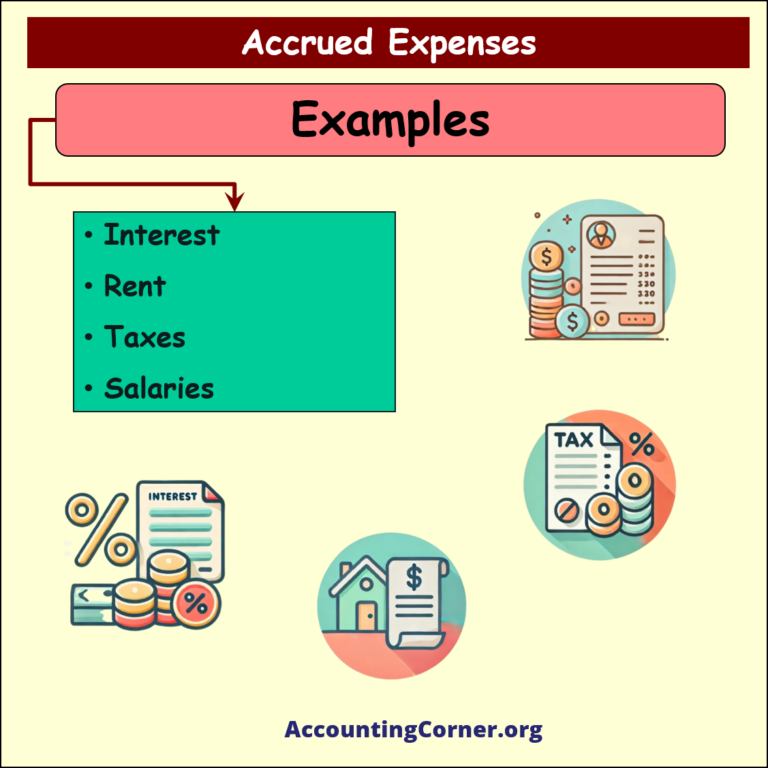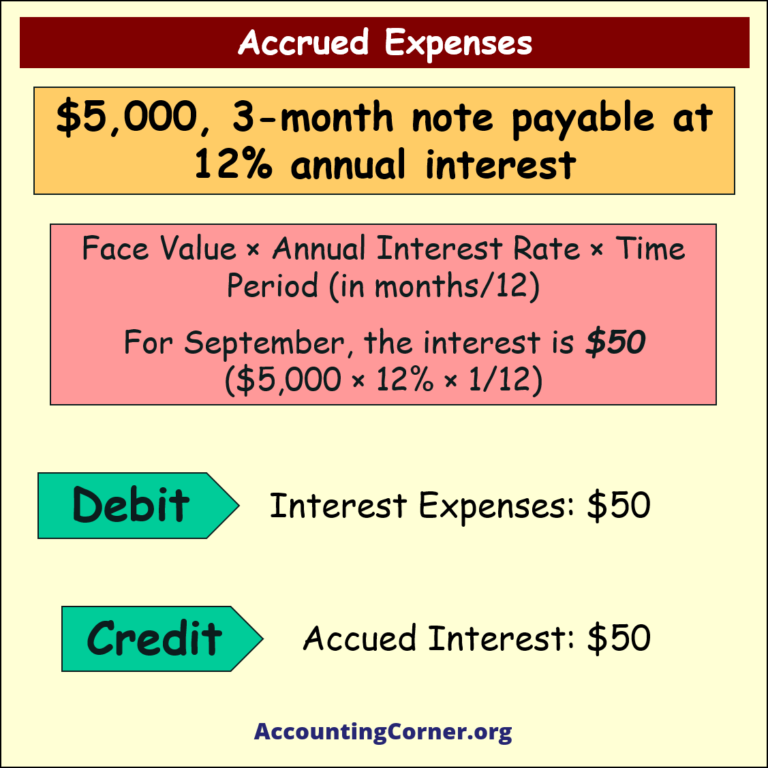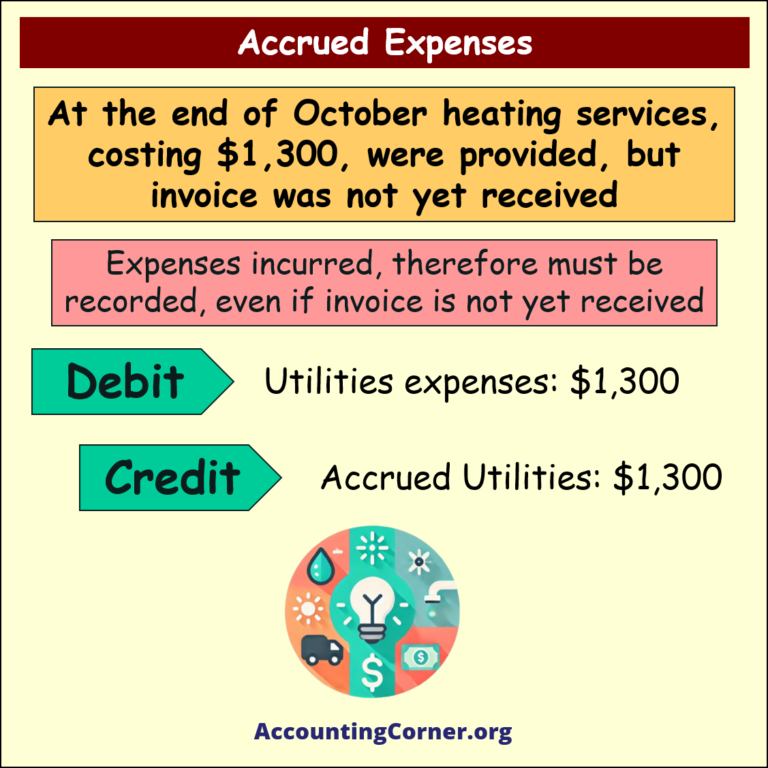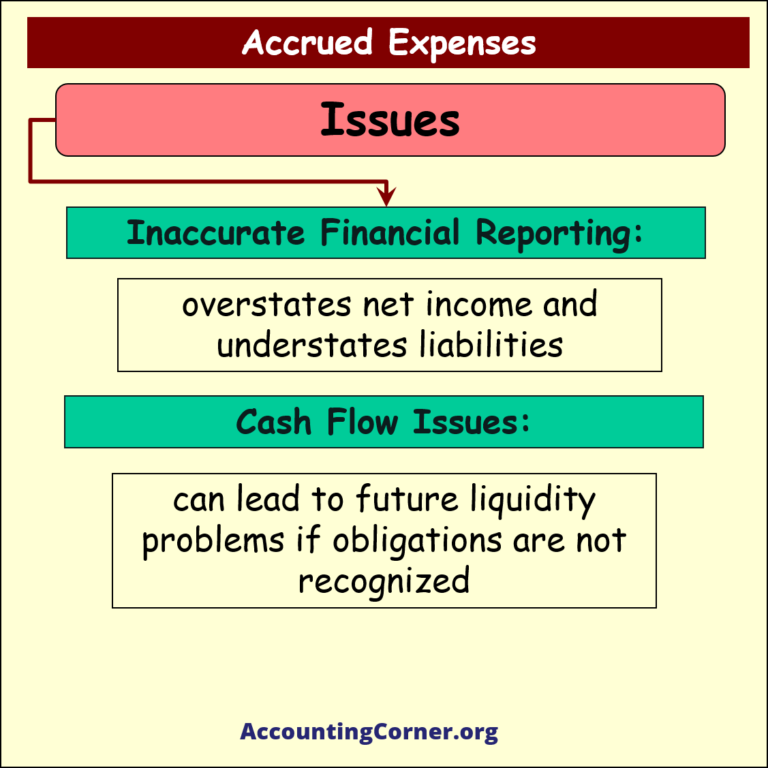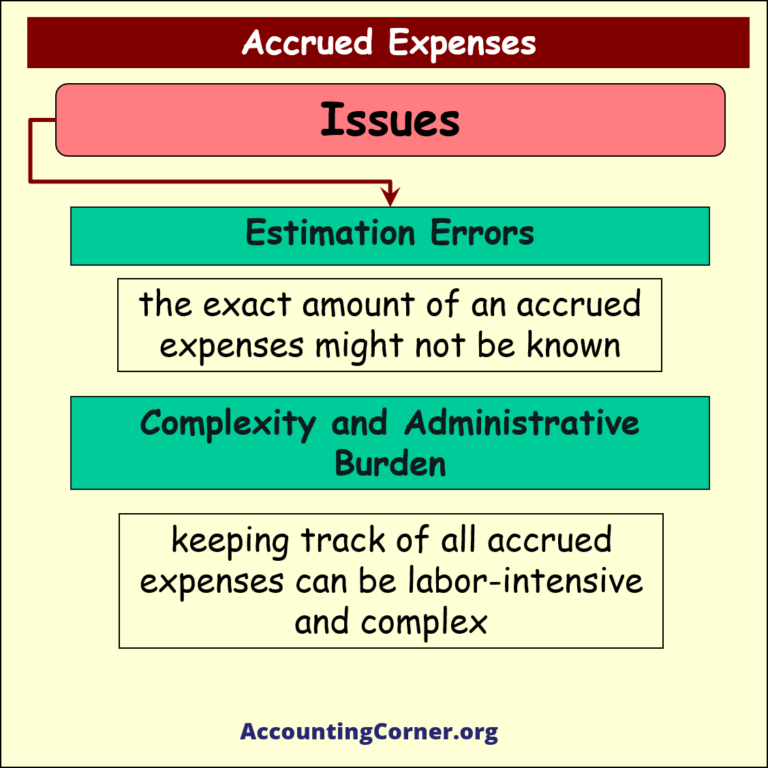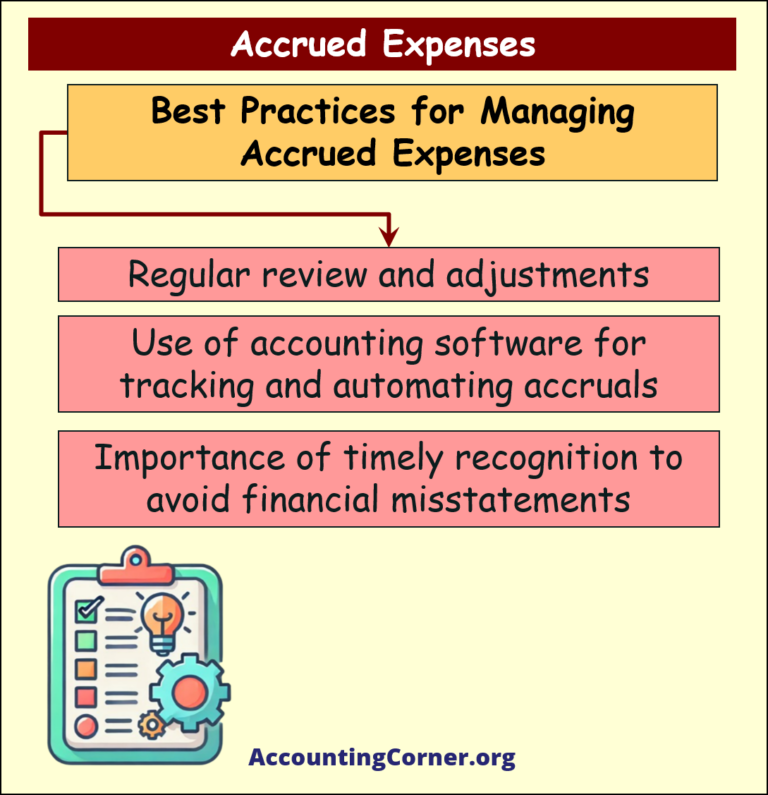Introduction to Accrued Expenses
Accrued expenses represent obligations for expenses that have been incurred but not yet paid by the company. These expenses are recorded in the financial statements before the payment is made, ensuring that they are recognized in the period in which they are incurred, rather than when the cash is disbursed. Accrued expenses are critical for providing an accurate view of a company’s liabilities and ensuring the matching principle in accounting is followed.
What Are Accrued Expenses?
Accrued expenses refer to costs that a company has incurred but has not yet paid. These expenses are recorded as a liability on the balance sheet and as an expense on the income statement through an adjusting entry. This adjustment ensures that expenses are recognized in the correct accounting period, even if the cash payment has not yet occurred.
Examples of Accrued Expenses:
- Interest
- Rent
- Taxes
- Salaries
- Utilities
Adjusting Entries for Accrued Expenses
To properly reflect accrued expenses in the financial statements, adjusting entries are required at the end of an accounting period. These entries increase both expenses on the income statement and liabilities on the balance sheet under accrued liabilities.
Basic Accounting Entry for Accrued Expenses:
- Debit: Expenses
- Credit: Accrued Expenses (Liability)
This adjustment ensures that expenses are recognized in the period they are incurred, providing a more accurate picture of the company’s financial obligations.
Example:
Suppose a company incurs a $5,000 3-month note payable with 12% annual interest. At the end of one month, the company will record an accrued interest expense:
- Interest Expense=$5000×12%×1/12=$50
The following entry is made:
- Debit: Interest Expense $50
- Credit: Accrued Interest $50
Impact of Accrued Expenses on Financial Statements
Accrued expenses affect both the income statement and the balance sheet.
- Income Statement: Increases expenses, reducing net income for the period.
- Balance Sheet: Adds to liabilities under the category of accrued liabilities, showing the company’s obligations at the balance sheet date.
Recognizing accrued expenses is essential for providing a complete and accurate view of the company’s financial obligations and preventing underreporting of liabilities and expenses.
Importance of Accrued Expenses
Accrued expenses are crucial for maintaining financial accuracy and adhering to the matching principle in accounting. By recognizing expenses in the period in which they are incurred, companies ensure that their financial statements reflect the true costs of operating the business. The following benefits highlight the importance of managing accrued expenses:
- Complete Financial Picture: Provides a clearer view of the company’s cash flow and obligations.
- Accurate Reporting: Avoids understatement of expenses and liabilities, which could mislead stakeholders and management.
- Regulatory Compliance: Ensures that financial statements comply with Generally Accepted Accounting Principles (GAAP) or International Financial Reporting Standards (IFRS).
Potential Issues with Accrued Expenses
While accrued expenses ensure accurate reporting, they also present some challenges:
- Inaccurate Financial Reporting: If accrued expenses are not properly recognized, the company’s financial statements may overstate net income and understate liabilities, leading to an inaccurate representation of the company’s financial health.
- Cash Flow Issues: Failing to account for accrued expenses may create cash flow problems in the future when these obligations must be settled.
- Estimation Errors: Accrued expenses are often estimated, and inaccuracies in these estimates can result in financial misstatements.
- Administrative Burden: Tracking and recording accrued expenses can be complex and time-consuming, especially for businesses with numerous outstanding liabilities.
Example of an Accrued Expense: Utility Bill
At the end of October, a company receives heating services but has not yet received the invoice. The estimated cost of the service is $1,300. The company must record the accrued expense even though the invoice has not been received.
Accounting Entry:
- Debit: Utilities Expense $1,300
- Credit: Accrued Utilities $1,300
This ensures that the expense is recorded in the period in which the service was provided, aligning the company’s financial reporting with the accrual accounting method.
Best Practices for Managing Accrued Expenses
To manage accrued expenses effectively, companies should follow these best practices:
- Regular Review and Adjustments: Regularly review accrued expenses and make necessary adjustments to ensure accuracy.
- Automation: Use accounting software to automate the tracking and recording of accrued expenses, reducing the risk of errors.
- Timely Recognition: Ensure that accrued expenses are recognized promptly to avoid misstating financial results.
- Estimation Accuracy: Improve the accuracy of accrued expense estimates by using historical data and maintaining clear communication with vendors and service providers.
Conclusion: The Strategic Role of Accrued Expenses
Accrued expenses are essential for maintaining financial transparency and ensuring that liabilities and expenses are recognized in the correct accounting period. Properly managing and recording accrued expenses helps businesses maintain accurate financial statements, comply with accounting standards, and avoid future cash flow challenges.
Summary Points:
- 📊 Definition: Accrued expenses are costs incurred but not yet paid, recognized as liabilities on the balance sheet and expenses on the income statement.
- 📝 Adjusting Entries: Required to record the obligation at the balance sheet date, ensuring expenses are matched with the period they occur.
- 📉 Impact on Financial Statements: Increases expenses and liabilities, reducing net income and accurately reflecting the company’s financial position.
- ⚠️ Challenges: Include estimation errors, cash flow management, and the administrative burden of tracking.
- 💼 Best Practices: Regular review, automation, and timely recognition are critical for managing accrued expenses effectively.
By recognizing and managing accrued expenses properly, businesses can ensure financial accuracy, avoid liquidity issues, and maintain compliance with accounting standards, leading to better overall financial health.
Accrued Expenses – Visuals
Accrued Expenses – Video
The Most Popular Accounting & Finance Topics:
- Balance Sheet
- Balance Sheet Example
- Classified Balance Sheet
- Balance Sheet Template
- Income Statement
- Income Statement Example
- Multi Step Income Statement
- Income Statement Format
- Common Size Income Statement
- Income Statement Template
- Cash Flow Statement
- Cash Flow Statement Example
- Cash Flow Statement Template
- Discounted Cash Flow
- Free Cash Flow
- Accounting Equation
- Accounting Cycle
- Accounting Principles
- Retained Earnings Statement
- Retained Earnings
- Retained Earnings Formula
- Financial Analysis
- Current Ratio Formula
- Acid Test Ratio Formula
- Cash Ratio Formula
- Debt to Income Ratio
- Debt to Equity Ratio
- Debt Ratio
- Asset Turnover Ratio
- Inventory Turnover Ratio
- Mortgage Calculator
- Mortgage Rates
- Reverse Mortgage
- Mortgage Amortization Calculator
- Gross Revenue
- Semi Monthly Meaning
- Financial Statements
- Petty Cash
- General Ledger
- Allocation Definition
- Accounts Receivable
- Impairment
- Going Concern
- Trial Balance
- Accounts Payable
- Pro Forma Meaning
- FIFO
- LIFO
- Cost of Goods Sold
- How to void a check?
- Voided Check
- Depreciation
- Face Value
- Contribution Margin Ratio
- YTD Meaning
- Accrual Accounting
- What is Gross Income?
- Net Income
- What is accounting?
- Quick Ratio
- What is an invoice?
- Prudent Definition
- Prudence Definition
- Double Entry Accounting
- Gross Profit
- Gross Profit Formula
- What is an asset?
- Gross Margin Formula
- Gross Margin
- Disbursement
- Reconciliation Definition
- Deferred Revenue
- Leverage Ratio
- Collateral Definition
- Work in Progress
- EBIT Meaning
- FOB Meaning
- Return on Assets – ROA Formula
- Marginal Cost Formula
- Marginal Revenue Formula
- Proceeds
- In Transit Meaning
- Inherent Definition
- FOB Shipping Point
- WACC Formula
- What is a Guarantor?
- Tangible Meaning
- Profit and Loss Statement Template
- Revenue Vs Profit
- FTE Meaning
- Cash Book
- Accrued Income
- Bearer Bonds
- Credit Note Meaning
- EBITA meaning
- Fictitious Assets
- Preference Shares
- Wear and Tear Meaning
- Cancelled Cheque
- Cost Sheet Format
- Provision Definition
- EBITDA Meaning
- Covenant Definition
- FICA Meaning
- Ledger Definition
- Allowance for Doubtful Accounts
- T Account / T Accounts
- Contra Account
- NOPAT Formula
- Monetary Value
- Salvage Value
- Times Interest Earned Ratio
- Intermediate Accounting
- Mortgage Rate Chart
- Opportunity Cost
- Total Asset Turnover
- Sunk Cost
- Housing Interest Rates Chart
- Additional Paid In Capital
- Obsolescence
- What is Revenue?
- What Does Per Diem Mean?
- Unearned Revenue
- Accrued Expenses
- Earnings Per Share
- Consignee
- Accumulated Depreciation
- Leashold Improvements
- Operating Margin
- Notes Payable
- Current Assets
- Liabilities
- Controller Job Description
- Define Leverage
- Journal Entry
- Productivity Definition
- Capital Expenditures
- Check Register
- What is Liquidity?
- Variable Cost
- Variable Expenses
- Cash Receipts
- Gross Profit Ratio
- Net Sales
- Return on Sales
- Fixed Expenses
- Straight Line Depreciation
- Working Capital Ratio
- Fixed Cost
- Contingent Liabilities
- Marketable Securities
- Remittance Advice
- Extrapolation Definition
- Gross Sales
- Days Sales Oustanding
- Residual Value
- Accrued Interest
- Fixed Charge Coverage Ratio
- Prime Cost
- Perpetual Inventory System
- Vouching
Return from Accrued Expenses to AccountingCorner.org home


